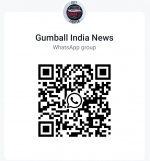If it’s not speed then what is the competition format of Gumball India?
Many have asked this question as typical competition is all about speed or least time from the start to the finish. Under Gumball India format the speed does not come in to play.
So how it is done?
At the start the competing crews are given a set of checkpoints that they have to touch before checking in at finish. All checkpoints have to visited or you are disqualified. Also fitted at start is a GPS logger in each car which record the location and speed of vehicle each and every second from start to finish.
For one this log of GPS is used for confirming that all checkpoints have been visited. For second the log record the total stoppage time by the crews. And lastly this log is used to work out the total distance travelled by the competing crews.
And these two factor are used to determine the winning crew.
SO the next question we get is why would travelling distance be different for different crews?
As no specific route is given the crews are free to take any road to reach the checkpoints. They are also free to do the checkpoint in any order.
Easiest example would be to take the case of any large city like Delhi or Ahmedabad or Hyderabad or Banglore. The convenient route across would be to take the outer bypass or ring road.
While it may be faster and an easier drive but this is always going to longer distance wise. The shortest distance is right through the heart of the city. Doing so is fraught with getting caught in traffic jams and increasing your stoppage time (increasing penalties)
The competitors have to weigh the alternative and decide on their course of action.
What is stoppage time penalty?
The total stoppage time of every crew is converted in to penalty distance using the following:
time x average speed of that competitor from start to finish
This prevents crews from driving fast and then taking a rest breaks.
